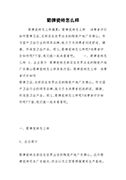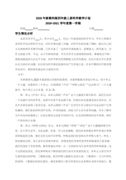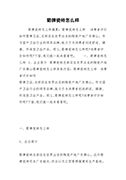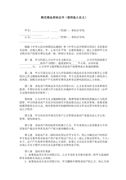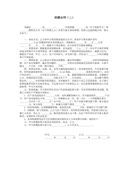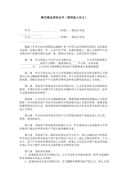《牛津小学英语》6B Unit 6 第六课时(精选14篇)六年级英语教案
《牛津小学英语》6B Unit 6 第六课时(精选14篇)
《牛津小学英语》6B Unit 6 第六课时 篇1
第六课时(6th period)一、主要新授内容(new contents)consolidation 二、学习目标(objectives)1、创设真实的语言情景,调动学生学习的积极性。2、结合本课主题—夏天,复习巩固单词summer ,sun ,cloud ,hot,beach,shell,sand等。3、在情景中运用 …is/are…. 正确描述观察到的景物,培养学生从小善于观察的良好习惯。4、在特定场景中会用let’s邀请别人做某事。。5、在正确的场合使用“i’m sorry.”,it’s ok.”6、在各类活动中激发学生学习的兴趣,养成良好的学习习惯。 三、教学建议1、任务前期准备阶段(pre-task preparation section)pre-task preparation是指我们要求学生运用目的语(即所学的语言)之前,呈现给学生的新语言材料。也就是我们常说的:input。本节课是一节复习课,在这个环节中应该营造良好的学习氛围,激发学生的学习兴趣。 activity 1 song1、教学辅助(aids)1) 图片电脑(2b-u7-27)2)屏幕 2.活动过程(process)stepscontentsmethodspurpose1introduce a new frienddo you like cartoons?who is he?i’d like you to meet a new friend.(出示图片) his name is mickey. he is a lovely mouse. 出示一个卡通人物,吸引学生的注意,激发他们的好奇心,营造良好的学习的氛围。2free talklet’s say hello to mickey.hello! how are you? …通过与mickey的对话,调动学生学习的积极性。 activity 2 listening1、教学辅助(aids)1)电脑(2b-u7-28)2)屏幕2.活动过程(process)stepscontentsmethodspurpose1look it is summer holiday.. mickey and his friends are going to a nice place.do you know which place it is?创设情景,为下面的活动作准备。 2guess: beachit is beautiful. we can sit under the umbrella.. we can pick up the shells.在听的过程中,不仅巩固了本单元的内容,也发展了学生的思维。 activity 3 (rhyme)1、教学辅助(aids)1)录音机2.活动过程(process)stepscontentsmethodspurpose1listen. on the beachmickey and his friends are reading a rhyme.they are very happy.(rhyme)创设情景,为下面的活动作准备。 2read and rhyme请学生和mickey一起朗诵这首儿歌..巩固对本单元单词的认读。 2、任务中期实施阶段(while-task procedure section)while-task procedure,这是指语言技能的习得过程。其中分为机械性操练和意义性操练两部分。机械性操练可以让学生准确地模仿、复说新授的语言,让他们经过从模仿到识记的过程,使新知识由感知、理解、模仿直到储存。由于本教时没有新授内容,在这个教学阶段可根据语言训练的需要创设一定语言使用环境,设计一些机械性操练和意义性操练。建议每项activity形式尽可能不同,时间不要长,一个活动紧接着一个活动,注意张弛结合,维持学习兴趣。 activity 1 let’s play1、教学辅助(aids)1)电脑(2b-u7-28)2)屏幕 2.活动过程(process)stepscontentsmethodspurpose1looking and saying(shell,umbrella,sun,cloud,sand)what can you see on the beach?i can see… 创设情景复习巩固单词,句型。2let’s….请学生邀请mickey做喜欢的事情eg: let’s eat ice-creams. activity 2 (memory game)1、教学辅助(aids)1) 电脑(2b-u7-29)2) 屏幕 2.活动过程(process)stepscontentsmethodspurpose1look and memorizemickey and his friends are watching tv. what do they see?(多媒体快速呈现各种画面有海滩景物、食物、学习用品等)what? how many?通过快速闪现的画面,吸引学生的注意,让学生在较短的时间内记忆图片内容,培养学生的直接思维。2competition将全班分成两大组进行比赛what do you see?i see _____ _______.在对话中巩固复数的运用与表达。activity 3 (dub)1、教学辅助(aids)1) 图片活动过程(process)stepscontentsmethodspurpose1i’m sorry. it’s ok.that’s all right. (出示mickey迟到,跑步撞到别人,忘记带作业,乱放文具等四幅图片)请学生以小组为单位讨论,你是mickey 你该说什么?创设真实的语言实践的环境,激发学生表达的兴趣。2dub请学生为情境配音通过创设的情境,让学生进行语言操练。 activity 4 ( an art lesson )1、教学辅助(aids)2)听力材料 2.活动过程(process)stepscontentsmethodspurpose1listen and draw. mickey and his friends are drawing now. let’s draw with them.(教师分发听力材料,听听画画)在听力练习中,培养学生良好的听力习惯。2talk about the pictures 根据听力材料上的内容,两人一组进行对话。为每位学生提供开口的机会。 3、任务后期完成阶段(post-task activity section) post-task activity,这是指经过机械性操练和意义性操练,引导学生运用他们所获得的知识与技能来完成一个交际性的任务“task”,也就是语言的输出:output。学生通过前两个阶段的学习,在知识和能力上已具备综合新旧知识进行交际的能力,教师可以根据学生的实际水平设计或选用提供的活动,使学生在相应的尽可能贴近生活的语境中,正确有效使用习得语言,完成交际性的任务。由于一年级的语言量非常有限,所以可以考虑借助练习册中相应的练习设计。 activity 1(read and colour )1、教学辅助(aids)1)学生练习册 2.活动过程(process)stepscontentsmethodspurpose1练习册第七22页read and circle.朗读单词,根据图片找到相应的单词,圈出正确单词课堂上完成练习册中的训练 2练习册第22页read and circle校对巩固本单元的学习内容 activity 2(pair work )1、教学辅助(aids)1)学生练习册 2.活动过程(process)stepscontentsmethodspurpose1练习册第23页color the picture. trace the sentences练习册,看第23页上的图片,两人之间讨论交流看到的内容可以体现学生之间的思维和语言积累的差异2练习册第六页colour the picture. trace the sentences选择部分小组向全班交流、表达他们的想法,适当渗透颜色,为下一单元的学习作准备。发挥学生的想象力,培养学生主动、灵活使用语言的能力 activity 3(sing a song )1、教学辅助(aids)1) 录音机 2.活动过程(process)stepscontentsmethodspurpose1sing a songit’s time to go home. mickey and his friends are on the bus again. they are very happy. they are singing.<shalala>在歌声中结束所有的活动,学生学得轻松,练得愉快。
牛津小学英语2b unit 7 第六课时 来自98e范文网。
《牛津小学英语》6B Unit 6 第六课时 篇2
教学内容:h. sing a song 练习册c、d、e、f部分
教学目标:
1.全面复习巩固本单元所学的单词句型。
2.理解歌曲内容,能准确唱出歌曲i wish i was taller。
3.通过练习,检查学生对所学知识的掌握情况,并以此提高学生的语言实际运用能力。
教学重点:熟练掌握并运用所学的单词、句型。
教学难点:培养学生阅读理解及书写的综合能力。
教具准备:录音机、磁带、图片、词卡等。
教学过程:
step1 warm up
1. greetings
2. sing a song.
①listen to the tape. ②简单介绍歌词大意. ③sing after the tape.(2遍)
3. free talk
结合学生的实际情况及室内现有物品,围绕本单元词句与学生展开闲谈。
step2 revision
1. listen and repeat.(a部分)
2. listen and answer.(d部分)
①who’s younger, su hai’s aunt or su hai’s mother?
②is the man is black su hai’s uncle?
③is su hai’s father stronger than su hai’s uncle?
④who’s older, su hai’s father or su hai’s uncle?
3. listen and write.(b部分形容词及其比较级)
4. look and write. 出示c部分图片,指导生写出对话。
5. choose and write.
bird, girl, skirt, t-shirt
the tall in the yellow and the blue has a .
step 3 do exercise.(练习册)
1. look, read and write(c部分)
①指导看懂题意. ②指导读懂表格内容及句子内容.
可采用问答形式帮助学生理解如:t: who is taller thon jack? who is younger than jack? who is heavier than tom?…
③生自由练习. ④read and check.
2. look and write.(d部分)
①指导生看图,谈论图意。
如:p1: who’s taller the boy or the girl.
p2: who’s stronger, the policeman or the doctor?
p3: who are heavier, the oranges or the pears?
p4: whose hair is longer?…
②生自由阅读并补充句子。 ③read and check.
3. look, read and write.(e部分)
①talk a bout the pictures.
t: what are they? who’s heavier? whose ears are longer? whose nose is shorter? who’s stronger?
②read the passage in pairs.
③complete the sentences. ④read and cheek.
4. read, write and answer.(f部分)
①read the dialogues in pairs.
②指生对话 ③指导理解对话内容
④answer the questions.
a: who is taller than john? b: is marg stronger than john?
c: what is john good at? d: where are they going?
⑤生自由阅读并完成练习 ⑥check it.
step 4 homework
1. read the text two times(a部分)
2. write the words two times(b部分)
3. make dialogues use the sentences of part c.
板书内容:
b部分词组 c部分句型及图片
板书设计:
教后笔记:
《牛津小学英语》6B Unit 6 第六课时 篇3
教学内容:《牛津小学英语》6b unit 3 asking the way复习本单元内容并完成补充练习。
教学目标:
1. 通过复习,使学生熟练掌握本单元所学的与问路有关的词汇。
2. 能较熟练地在情境中运用本单元所学的句型和日常交际用语。。
3. 能进一步掌握句型can you tell me the way…? how can i …及其答语。
教学重点:can you tell me the way…? how can i …?及其答语。
教学难点:能综合运用本单元所学的单词、句型和日常实际用语。
教具准备:本单元的单词卡,补充练习的听力磁带、录音机、一张自制城市交通图。
教学过程:
step 1 warm up:
1. sing a sang: excuse me
2. chant: where’s the bookshop?
3. free talk:
师生利用地图围绕本单元所学的单词、句型进行问路对话。
t:excuse me. can you tell me the way to…, please?
s:go along this street,…
t:how fat is it from here?
s:it’s about… away.
t:how can i get there?
s:you can take… and get off at…
step2 revision
1. 请学生复述或表演a部分会话。
2. 根据课文内容,教师提出问题,让学生判断正误。
step3 do some exercise.
教师指导学生完成本单元的补充习题。
1. a listen and number
①指导学生仔细观察每幅图的内容,看清图意。
②认清每幅图的场所。
③听录音排序号。
2. b listen and match.
①指导学生说出图中的人物、地点和交通工具。
②听录音连线。
3. c look, read and write
①指导学生看图口头说出完整的句子。
②拼读单词和词组。
③根据图意填词或词组。
4. d read and judge
①指导学生认真阅读短文。
②根据题目中的句子,在课文中找出相应的内容画出来,进行比较,判断句子的对错。
5. e look, read and complete.
①指导学生看图,根据图上的内容口头完成句子。
②在学生整体朗读对话后,再书面完成。
6. f read and write
①仔细阅读句子,联系所给情景,理解句意。
②根据内容给对话排序。
7. 集体校对答案,可指名回答问题。
step4 homework
1. 熟读并抄写补充练习中f read and write图1和图3的对话。
2. 思考:nancy想来我们这儿做客,你能为她推荐两个本地最著名的风景区或最值得去的地方并为他指路吗?课后分小组自编情景对话并画出简图。
板书设计:
《牛津小学英语》6B Unit 6 第六课时 篇4
教学内容:6b第五单元第六课时。
教学目标:练习册a listen and number, b listen and match, c look, think and write,
d look and write, e read, think and write,f read and answer.
教学重点:能独立完成a、b两部分听力测试。
教学难点:能在教师指导下完成c、d、e和f部分笔试练习,找到做题方法。
教具准备:单词卡片、教学挂图、录音机。
教学过程:
step 1 pre-task preparation:
1.say a rhyme: seasons
in autumn, when the leaves start to fall.
i like to run, jump and kick a ball.
in winter, when there’s lots of snow.
the cold winds start to blow and blow.
i stay at home and wait for spring.
and the fine weather it’s going to bring.
i wait for summer when the sun is hot.
then i can play games and swim a lot.
2.say a chant:
spring, summer, autumn and winter,
which season do you like best?
spring, spring, i like spring best.
summer, summer, they like summer best.
autumn, autumn, we like autumn best.
winter, winter, we all like winter.
summer is hot, winter is cold,
autumn is cool and spring is warm
spring is sunny, summer is rainy,
autumn is cloudy and winter is windy..
step 2 while-task procedures:
a listen and number:
本题要求学生听清每段所描述的内容,看清图后再标号。重要的是让学生明白听录音中的关键词。
b listen and match:
本题中有的选项会重复使用,有的是空白选项。应先听懂短文内容,再根据所给内容连线。
c look, think and write:
完成本题前要正确理解图意,认清所画地点和季节特点,并正确拼写单词。
d look and write:
做本题前要仔细看图,认清图画中季节与相关气候后在正确写出所缺内容。注意联系上下文完成本题。
e read, think and write:
阅读短文,熟悉课文内容并正确理解意思,再国家所给内容完成。a项注意写全答案,b项写句子时应注意完整,特别要注意前后人称、时态是否正确。
f read and answer:
阅读短文,正确理解短文意思,再回答问题。教会学生做题方法:带着问题读短文,答案就在短文里。
step 3 post-task activity:
1.pair work:同桌核对练习的答案。
2.group work:小组讨论,有无不一致的地方。有时答案不是唯一的。
step 4 homework:
1.listen to the tape of unit 5.
2.say a rhyme.
板书内容:
summer, cloudy, winter, windy, autumn, spring, countryside, sunny.
板书设计:
《牛津小学英语》6b unit 5 第六课时 来自98e范文网。
《牛津小学英语》6B Unit 6 第六课时 篇5
【教学设计(teaching design)】unit 6 eating and drinking第六课时(6th period)一、主要新授内容(revision)let’s act---bring me … / give it to ….let’s talk--- i am hungry / thirsty. i want… …? yes, please. / no, thanks.let’s learn---bowl, plate, glass, fork, knife, spoon, chopstickslet’s play---what do you want? i want …. let’s enjoy---story 二、学习目标(objectives)1、通过在“eating and drinking”的主题中,复习巩固询问对方想要的事物或饮料所使用的相互简单的问答方式和给人指令的简单表达,让学生形成在日常生活中良好的语言习惯和培养他们对英语的浓厚兴趣。2. 在“picnic”的语言使用环境中,复习巩固餐具名称bowl, plate, glass, fork, knife, spoon, chopsticks七个词汇3. 在前几个节课的学习基础上,能熟练运用what do you want? i want…., …? yes, please. / no, thanks. 及 i am hungry / thirsty. i want…4. 根据二期课改新课标的要求,在确保完成基本教学目标的基础上,可以结合学生的学习能力和语言的实际使用对教材呈现的教学内容进行拓展,使学生使用的语言更丰富多样,有助于学生在实际生活中对语言的理解和表达更为准确和真实。 三、教学建议1、任务前期准备阶段(pre-task preparation section)pre-task preparation是指我们要求学生运用目的语(即所学的语言)之前,呈现给学生的新语言材料。也就是我们常说的:input。在这个环节主要让学生获得对新语言材料的第一次感知。 1、复习阶段一(revision section i)根据学生已经掌握的知识技能,围绕本单元的主题和语用环境,综合前几节课的学习,学生在知识和能力上已具备综合新旧知识进行交际的能力,教师可以根据学生的实际水平设计或选用提供的活动,使学生在相应的尽可能贴近生活的语境中,正确有效地使用习得语言,完成交际性的任务。 activity 1 story1、教学辅助 (aids)1)picture book 2.活动过程(process)
stepscontentsmethodspurpose1look and listen:老师给学生讲一个故事: having a picnicinto the park.up the hill to look at the vies.down to the pond to feed the ducks.where’s the picnic? here it is.
who’s this? look out! ducks!they’ve taken the buns.have a good picnic. 引起学生的视觉注意,激发学习兴趣,创造一个picnic的情景。2question:教师问学生野餐时需要准备哪些餐具。复习单词,加以合理运用,加深学生理解
activity 2 (jigsaw reading)1、教学辅助 (aids)1) worksheet 2.活动过程(process)
stepscontentsmethodspurpose1jigsaw reading:两个学生一组,分别有不同填空内容的worksheet,在齐读后,根据对方提供的信息,完成自己的空格。e.g. a; there are two _____ on the table.b. there are ______ bowls on the table.(复习餐具名称) 同组的学生手中的worksheet中的内容之间存在信息差,有利与激发学生的兴趣,提高交际的质量。 2check:请个别学生朗读句子,其余同学检查 jigsaw reading做得正确与否。教师检查活动的质量,培养学生听说能力。
2、复习阶段二(revision section ii)通过以上的复习,学生已经具备了综合运用已学知识的能力,再此基础上教师根据学生的实际能力和口语交际的需要,进行适当的拓展,指导学生以不同的方式形容人物的外形和特点,丰富学生的语言表达方式。 activity 1 listen and judge1、教学辅助(aids)1) 电脑2b-u6-13 2b-u6-142)屏幕 2.活动过程(process)
stepscontentsmethodspurpose1look and discuss:电脑画面(2b-u6-13)上出现爸爸、妈妈和孩子。桌子上有一些水果、饮料、一台照相机、一块垫子,教师和学生一起讨论他们准备干什么。以小组交流的方式创设语言交际的平台,充分发挥学生的主体作用。2listen and judge电脑画面(2b-u6-14)上出现妈妈和一个小孩:妈妈:sam, bring me a bowl.孩子拿了一个盘子给妈妈。学生判断。妈妈:sam, kitty is thirsty.孩子拿了一些米饭给kitty猫。学生判断。…通过观看画面,听一听,作出判断,既训练了学生的听力,又对所学知识进行了巩固。
activity 2 look and say1、教学辅助(aids)图片 2.活动过程(process)
stepscontentsmethodspurpose1look and think老师出示一些图片:1.一个孩子,旁边bubble中有一些苹果2.一个老人,旁边bubble中有一些牛奶3.一个老师,旁边bubble中有一些书4.一个妈妈,旁边bubble中有一把*子老师要求学生仔细观察,想想图片中的人物会说些什么。 鼓励学生仔细观察,充分发挥他们的想象能力。2say sth about the picture学生通过思考后表达:i want…i have …i like to eat…there are some…. 激活学生的旧知,鼓励学生用学过的内容看图说话,
activity 2 dialogue1、教学辅助(aids)图片2.活动过程(process)
stepscontentsmethodspurpose1discuss:教师问学生可以为party准备什么饮料 / 水果 / 菜肴 / 餐具 / ?为下一步output作铺垫。2act out the dialogue:以小组形式表演对话:i’m hungry / thirsty.i want……?yes, please. / no, thanks. 通过小组表演指导学生使用多种多样的语言表达形式
3、复习阶段三(revision section) 通过前阶段的口语交际操练,学生在知识技能的听说方面已具备了相应的能力,下一阶段的任务是读写能力的跟进。由于受一年级学生的年龄特点的制约,教师在设计练习时要尽量侧重于认读,逐步培养学生的阅读和书写能力。 activity 1(exercise )1、教学辅助(aids)1)练习卷2)录音机 2.活动过程(process)
stepscontentsmethodspurpose1练习卷第一题: listen and tick练习卷第一题,根据听到的内容,在表格里勾出合适的词。可以体现学生之间的听力和理解、认读单词能力的差异2练习卷第二题circle the word圈出不同类的词(水果,饮料,餐具,…)可以了解学生对同类词的掌握情况
activity 2(exercise )1、教学辅助(aids)1) 练习卷2) 录音机 2.活动过程(process)
stepscontentsmethodspurpose1练习卷第三题listen and circle the words you hear请学生根据听到的内容,选择正确的单词: q: platea. plane b. play c. plate 了解学生认读单词的能力2练习卷第四题listen and choose the correct answer让学生根据听到的问句,选择合适的答句q: what do you want?a: yes, i am hungry.b. i want some rice.c. i want some water.d. yes, please. 训练学生的听力水平,理解能力和应用能力
activity 3(exercise )1、教学辅助(aids)练习卷 2.活动过程(process)
stepscontentsmethodspurpose1练习卷第五题read and draw认读句子后,画一画:q: what do you want? i i want four apples.学生画四个苹果。 检查学生认读句子的能力2练习卷第六题look, read and choose让学生根据图片,阅读句子,选择恰当的词填入空格内 i am ______. i want some milk.a. hungry b. thirsty c. cold 训练学生的认读和理解能力
activity 4(exercise )1、教学辅助(aids)练习卷 2.活动过程(process)
stepscontentsmethodspurpose1练习卷第七题match and say请学生根据自己的实际情况,连线相应的单词或图片, 并能连贯地说出: i am …. i want…/ 联系学生的实际愿望作选择2练习卷第七题read and judge根据中文给出的情景,判断所给的英语句子是否正确。训练学生的思维、判断能力。
activity 5(exercise )1、教学辅助(aids)练习卷 2.活动过程(process)
stepscontentsmethodspurpose1练习卷第八题read 请学生阅读一段较简短的故事 we have a picnic today. we have some apples, some pears, some juice and so on. i am hungry. i want some bananas. may is thirsty. she wants some coke. … 培养学生的阅读能力2练习卷第八题choice请学生阅读短文后,选择人物所需要的正确食物。培养学生的阅读技巧和理解能力,训练学生的思维判断能力
附件:媒体制作说明1. 2b-u6-13: 画面上出现爸爸、妈妈和孩子。桌子上有一些水果、饮料、一台照相机、一块垫子,2. 2b-u6-14: 画面上出现妈妈和一个小孩:妈妈说:sam, bring me a bowl.孩子拿了一个盘子给妈妈。妈妈说:sam, kitty is thirsty. 孩子拿了一些米饭给kitty猫。
牛津小学英语2b unit 6 第六课时 来自98e范文网。
《牛津小学英语》6B Unit 6 第六课时 篇6
教学内容:综合实践课
教学目标:
1训练学生基本语言技能为目标,培养学生大胆用英语表达的勇气,养成用英语思维的习惯。
2.以听说读写的形式,综合训练学生对本课单词、句型的理解和应用。
3.鼓励学生合作学习,共同发展。
教学重难点:培养学生综合运用语言的能力。
教具准备:石英钟(以便一分钟记时),小黑板或纸张(上面准备20-25个句子),录音机。
教学过程:
step 1 group work: what have you learnt?
1.小组内交流本单元所学内容。(分单词、句型两大块,每块再分重点及次重点。)
2.记到笔记本上,互相读一读,问一问。
3.全班交流。
step 2 listening exercise听力练习
1.listen and judge(完成练习册第1页)
1)look at the pictures.
2)what can you see?
3)listen to the tape and draw a smiling or crying face.
4)check the answers.
2. listen and choose.(完成练习册第2页)
1)look at the pictures and say the words.
2)listen to the tape and choose the correct letter.
3)check the answers.
step 3 oral exercise口语练习(完成练习册第5页)
1. check the answers.(上节课布置的作业)
2. read the dialogues together.
3. try to act out the dialogues. (group work)
4. action.
step 4 reading work读句竞赛
训练方式:读小黑板或纸上的20-25个句子(本课句型或其它)小组间竞赛,每人读一句。一分钟之内,读的句数最多的一组为胜。
step 5 writing work写话练习。
练习形式:每组发一张纸,以 hello/ good morning/ … 开头,每人接一句,一直接下去,5分钟之内完成合作。
教师快速阅读一下,再分发下去,学生互相评价。最后齐读范文。
step 6布置作业。
1.背诵a部分。
2.你能发现多少单词:
newomanclimboyourighteacherstudenteamanurse
3.你会说吗?
1)你第一次到一个新的地方,可以说:
2)你不知道一个人是谁,可以问其他人:
3)当你打扰别人时,应该先说声:
板书内容:(请合理安排)
板书设计:
教后笔记:
《牛津小学英语》6B Unit 6 第六课时 篇7
教学内容: g. listen and repeat h. say a rhyme及练习册
教学目标:
1、熟练掌握四会词汇和句型。
2、了解字母组合ur在单词的读音。
3、有表情地诵读歌谣i want to write a letter。
教学重点:
1、熟练掌握四会词汇和句型。
2、了解字母组合ur在单词的读音,并能扩充举例。
教学难点:正确理解歌谣含义,并能有表情地诵读。
教具准备:挂图、磁带、小黑板
教学过程:
step 1 warm up
1、greeting
2、listen a rhyme: i want to write a letter.
3、revision.
组织学生听d部分录音资料,提问相关问题:
①how old is helen? ②does helen live in nanjing?
③what’s the name of helen’s school? ④what are helen’s hobbies?
回答时学生间可采用男、女间,半班间,同桌间等多种问答形式进行操练。
step 2 presentation
1、listen and repeat
本部分是语言训练项目,教师应指导学生正确朗读单词及句子,并让他们体会字母组合ur在单词中的读音。
①教师让学生自己朗读单词,边读边体会字母组合ur在单词中的读音。
②出示单词hurt, nurse, thursday, turn,集体认读。
③指导学生听录音跟读单词和句子。
④教师引导学生看黑板朗读,也可在学生中展开朗读竞赛,看谁读得又快又准。
⑤鼓励学生自己归纳整理其它例词,编写成绕口令或句子练习朗读。
2. say a rhyme
①教师播放小诗录音,引导学生分句跟读。
②教师与学生按节奏诵读小诗。诵读时可根据节奏和内容做动作,以帮助记忆。
③指名读。 ④小组间试着编歌谣。
step 3 doing exercises
1. listen and number
听录音,根据所听到内容的先后顺序,在相应图中的方框内写上序号。
教师让学生先看图,用英语说出节目名称,再做此练习。
2. listen read and judge
听录音,读句子,根据所听内容判断句意是否正确。
教师让学生先看句子,读懂大意,听录音时注意进行方法指导。
3. look and write
看图,根据上下文完成句子。
教师指导学生边看图边读句子,在此基础上完成此项练习。
4. read and answer
朗读短文,根据短文内容回答问题。
5. read and complete
朗读并完成句子。
6. look, read and write
看图完成句子。
step 4 homework
1、练习册中的e、f两题作为家庭作业。
2、朗读并抄写本单元要求四会的单词各两遍,句子各两句。
3、鼓励学有余力的学生用英语与外籍朋友或其他学校的学生通信。
板书内容:
1、课题:unit 7 a letter to a penfriend
2、单词:hurt, nurse, thursday, turn
3、句型:last thursday the nurse hurt her fingers and they turned black and blue.
板书设计:
《牛津小学英语》6B Unit 6 第六课时 篇8
第六课时(6th period)一、主要新授内容(new contents)consolidation 二、学习目标(objectives)1、创设真实的语言情景,调动学生学习的积极性。2、结合本课主题—time,复习巩固单词watch, clock, day, night, breakfast, lunch dinner等。3、在情景中运用what time is it? it’s ___ o’clock.. it’s ___ o’clock. i get up. / go to school/ have lunch ... 等, 培养学生守时,不迟到的良好习惯。4、在日常生活中会用 get up, go to bed, have breakfast/lunch/dinner. 5、熟练掌握数字1至12的表. 6、在各类活动中激发学生学习的兴趣,养成良好的学习习惯。 三、教学建议1、任务前期准备阶段(pre-task preparation section)pre-task preparation是指我们要求学生运用目的语(即所学的语言)之前,呈现给学生的新语言材料。也就是我们常说的:input。本节课是一节复习课,在这个环节中应该营造良好的学习氛围,激发学生的学习兴趣。 activity 1 game1、教学辅助(aids)1) 头饰 2.活动过程(process)stepscontentsmethodspurpose1introduce a new game. 老狼,老狼,几点了?学生站在老师身后较远处,学生问:what’s the time, mr. wolf?然后根据老师回答的时间数向前跨步,如教师答it’s three o’clock.学生则镶嵌跨3步,只有12 例外,听到12则学生不能移动,违者罚出局。先碰到老师的学生为胜。出示一个老狼头饰,吸引学生的注意,激发他们的好奇心,营造良好的游戏氛围。2play a game. ss: what’s the time, mr. wolf?t: it’s ____ o’clock.通过与老狼的对话,复习时间表达,调动学生学习的积极性。 activity 2 listening and saying 1、教学辅助(aids)1)图片2) 录音机3) 听力练习纸2.活动过程(process)stepscontentsmethodspurpose1look look. the sun is shinning. the birds are singing. it’s seven o’clock sam gets up. he brushes his teeth and washes his face. it’s seven thirty. he has breakfast.... .创设情景,为下面的活动作准备。 21.match. 2.check3. say a story.( pair work)1.看图听录音,将下列图片与时钟连起来。2.抽1-2位汇报3.同桌看图讲故事。根据内容自由扩展故事在听的过程中,不仅巩固了本单元的内容,也发展了学生的思维。 activity 3 (guessing)1、教学辅助(aids)1)电脑(2b-u8-20)2)屏幕 2.活动过程(process)stepscontentsmethodspurpose1look (多媒体画面出现早餐,午餐,晚餐,起床,睡觉,上学,看电视等场景,边出示画面边配上语言的input, 描述每一幅图)创设情景,为下面的活动作准备。 2read and match1. 教师问:what time is it? why?2. 请学生为每幅图配上时钟通过为每幅图配上时钟活动,巩固本单元单词和句子的认读。 2、任务中期实施阶段(while-task procedure section)while-task procedure,这是指语言技能的习得过程。其中分为机械性操练和意义性操练两部分。机械性操练可以让学生准确地模仿、复说新授的语言,让他们经过从模仿到识记的过程,使新知识由感知、理解、模仿直到储存。由于本教时没有新授内容,在这个教学阶段可根据语言训练的需要创设一定语言使用环境,设计一些机械性操练和意义性操练。建议每项activity形式尽可能不同,时间不要长,一个活动紧接着一个活动,注意张弛结合,维持学习兴趣。 activity 1 make a picnic plan1、教学辅助(aids)1) 投影仪 2.活动过程(process)stepscontentsmethodspurpose1复习学过的各种活动名称。what do you like to do?what do you like to do in spring/summer?1. 创设野餐活动过程的情景,在活动中巩固时间与活动的表达。2. 拓展picnic plan2find your friendswrite down a picnic plane.g. 7:30 get up 8: 00 go to the park 9: 00 play games ... ... activity 2 (memory game)1、教学辅助(aids)1) 电脑(2b-u8-21)2) 屏幕 2.活动过程(process)stepscontentsmethodspurpose1look and memorizesam and his friends are in the tv room. they are watching tv. what do they see?( 多媒体画面出现早餐,午餐,晚餐,起床,睡觉,上学,看电视等场景,边出示画面边配上语言的input, 描述每一幅图))what do you see? what time is it?通过快速闪现的画面,吸引学生的注意,让学生在较短的时间内记忆图片内容,培养学生的直接思维。2competition将全班分成两大组进行比赛每闪一幅图,两组抢答。描述多者为胜。.在复述中巩固时间与活动的运用与表达。 activity 3 ( act and rhyme)1、教学辅助(aids) 2.活动过程(process)stepscontentsmethodspurpose1act and chant one little, two little., three little boys. ... 表演第一教时学的儿歌。 在紧张的比赛后,使学生放松心情,念念儿歌,缓解紧张的情绪。2a new rhyme欣赏一首新的儿歌one ,two, three, clime the tree.four, five, six,pick up sticks. ......拓展新的儿歌,激发学生的兴趣。 activity 4 ( an art lesson )1、教学辅助(aids)1)听力材料 2.活动过程(process)stepscontentsmethodspurpose1listen and drawit is an art class. sam and his friends are drawing now. let’s draw with them. now it’s six in the morning, sam get up. it’s eight o’clock, sam ... . (教师分发听力材料,听听画画)在听力练习中,培养学生良好的听力习惯。2talk about the pictures 根据听力材料上的内容,两人一组进行对话。为每位学生提供开口的机会。 3、任务后期完成阶段(post-task activity section) post-task activity,这是指经过机械性操练和意义性操练,引导学生运用他们所获得的知识与技能来完成一个交际性的任务“task”,也就是语言的输出:output。学生通过前两个阶段的学习,在知识和能力上已具备综合新旧知识进行交际的能力,教师可以根据学生的实际水平设计或选用提供的活动,使学生在相应的尽可能贴近生活的语境中,正确有效使用习得语言,完成交际性的任务。由于二年级的语言量非常有限,所以可以考虑借助练习册中相应的练习设计。 activity 1(read and colour )1、教学辅助(aids)1)学生练习册 2.活动过程(process)stepscontentsmethodspurpose1练习册第25页read and match.朗读单词,根据图片找到相应的单词,完成练习课堂上完成练习册中的训练 2练习册第25页read and trace.1. 校对2. trace the words巩固本单元的学习内容 activity 2(look, listen and say)1、教学辅助(aids)1)学生练习册 2.活动过程(process)stepscontentsmethodspurpose1练习册第24页look, listen and say the correct response..练习册,看第24页上的图片,听录音说出正确的应答句。 培养学生主动、灵活使用语言的能力2练习册第24 页(pair work ).选择部分同桌向全班交流。
牛津小学英语2b unit 8 第六课时 来自98e范文网。
《牛津小学英语》6B Unit 6 第六课时 篇9
教学内容:《牛津小学英语》6b unit 6补充习题
教学目标:
1. 熟练掌握本单元所学内容。
2. 掌握《补充习题》内容。
教学重点:熟练掌握本单元所学内容。
教学难点:掌握《补充习题》内容。
教具准备:录音机、磁带等。
教学过程:
step 1 warm up
1. greetings
2. free talk
学生以小组形式就本单元所学的日常交际用语进行交谈。
step 2 presentation and consolidation
1. listen and choose.
①教师指导学生理解图意,说出短语。
②学生听录音完成练习。
③集体订正,再听录音,指名学生重复。
2. listen and tick.
①教师指导学生看表格并说出短语。
②学生听录音完成练习。
③集体订正,再听录音,指名学生重复。
3. read and write.
①学生独立完成练习。
②集体订正,教师相机板书。
③学生画出短语,校正答案。
④学生齐读。
4. look, think and write.
①学生独立完成练习。
②集体订正,教师相机板书。
③学生画出短语,校正答案。
④学生讨论易错的地方,并汇报交流。
⑤学生齐读。
5. look, read and write.
①学生独立完成练习。
②集体订正,教师相机板书。
③学生找出短语并校对答案。
④学生齐读。
6. read and answer.
①学生独立完成练习。
②教师带学生看短文后问题并讲解其含义。
③教师带学生读短文,理解其意。
④学生找出短语,师生校对答案。
⑤讲解短文后问题答案并板书。
⑥学生齐读。
step3 homework.
1. 写补充习题c read and write 和e look, read and write 1 遍。
2. 复习本单元所学内容。
①四会单词和四会句型默1遍,保证会默。
②读unit 6 的书1遍并试着背诵或复述。
板书内容(略)
板书设计:
《牛津小学英语》6B Unit 6 第六课时 篇10
教学内容:综合实践课
教学目标:
1. 以训练学生基本语言技能为目标,培养学生大胆用英语表达的勇气,养成用英语思维的习惯。
2. 以听说读写的形式,综合训练学生对本课单词、句型的理解应用。
3. 鼓励学生合作学习,共同发展。
教学重难点:培养学生综合运用语言的能力。
教具准备:录音机
教学过程:
step1 group work:what have you learnt?
1. 小组内交流本单元所学内容。(分单词、句型两大块,每块再分重点及次重点)。
2. 记到笔记本上,互相读一读,问一问。
3. 全班交流。
step2 listening exercise 听力练习。
1. listen and judge.(完成练习册a部分)
①look at the pictures.
②what can you see?
③listen to the tape and judge.
④check the answers
2.look, listen and choose.
①look at the sentences.
②listen to the tape and choose the correct answer.
③check the answers.
step3 oral exercise 口语练习
以jump为话题,小组合作,进行英语会话。
1. group work. 小组内进行。
2. english show. 选出优秀选手,全班展示。
step4 reading work. 完成练习册f部分。
1. read and put the sentences in the right order.自由读短文,完成排序。
2. 指名读。
3. 核对答案。
4. 齐读短文。
step5 writing work. 写话练习
练习形式:每组发一张纸,以i’m not happy开头,每人接一句,一直接下去,5分钟之内完成合作。
教师快速阅读一下,再分发下去,学生互相评价,最后齐读范文。
step6 布置作业
1. 完成练习册14、15、16、页。
2. 你能发现多少单词:aslowalkwellateanimalowatchavexercise
板书内容:
(请合理安排)
板书设计:
《牛津小学英语》6B Unit 6 第六课时 篇11
教学内容:《牛津小学英语》6b unit 6 f play a game g listen and repeat h sing a song.
教学目标:
1、了解字母组合ow在单词中的读音。
2、能唱歌曲will you join me?
3、熟练掌握本单元所学内容。
教学重点:熟练掌握本单元所学内容。
教学难点:了解字母组合ow在单词中的读音。
教具准备:录音机、磁带、小黑板、骰子、棋子等。
教学过程:
step1 warm up
1. greetings
2. free talk
就本单元所学的内容进行自由交谈,可采用师生间、生生间、小组间等形式进行。
step2 revision
1. 齐读e read and number。
2. 学生小组内准备朗读并表演对话。
3. 教师抽查,全班评议。
step3 presentation and consolidation
1. play a game
①教师事先布置学生根据图例,了解有关游戏规则和方法,准备好游戏工具,包括骰子和棋子。
②指导学生可在小组内开展游戏活动。
③教师抽查学生开展游戏的情况。
④教师可鼓励学生自己自创新的玩法,在游戏中进一步巩固所学知识。
2. listen and repeat
①教师让学生自己朗读单词,边读边体会字母组合ow在单词的读音。
②指导学生听录音跟读单词和句子,教师可利用图片或多媒体课件帮助学生理解句意。
③教师可指导学生朗读,也可在学生中开展朗读比赛。
④学生自己归纳整理其他例词,编写绕口令或其他句子并练习朗读。
⑤汇报结果,教师相机板书。
snowmen
snowball
row rowing
show know
snow
blow low
snowy
snowman
lower slow
slower
3. sing a song
①讲解歌词大意。
②读歌词。
③听录音。
④听录音跟唱。
step4 homework
1、全面复习本单元所学内容。
2、背诵g listen and repeat并试着归纳其它例词。
3、预习《补充习题》unit 6。
板书内容
snowball
snowmen
snowman
snowy
snow
row rowing show
blow know low
lower slow slower
板书设计:
《牛津小学英语》6B Unit 6 第六课时 篇12
unit 2 more exercise
连云港市赣榆县青口中心小学 范文艳
单元教材分析:
本单元引入了副词比较级。话题围绕着jim和他爸爸谈论如何进行体育锻炼展开,课前教师可设计一个学生自己制定锻炼身体的计划的任务,使学生把所学的语言知识与生活实际联系起来,有些副词的比较意义较为抽象,如late, later, early, earlier, well, better,建议教师在教学中尽可能地用具体的手段帮助学生理解这一难点。
教学要求:
1、能听懂、会说、会读和会拼写单词strong, slow, low, fish, late及be good at。
2、能听懂、会说和会读单词和词组far, well, jog, do well in, need help with, do more exercise, animal show, go for a walk。
3、能听得懂、会说和会读日常交际用语that’s true. well done. mike runs as fast as ben.
4、能听得懂、会说、会读、会写句型ben runs faster than jim. do the boys jump higher than the girls? does jim swim slower than david?
5、了解字母组合or在单词中的另一种读音。
6、会诵读歌谣run, rabbit, run!
教学重难点:
1、能听懂、会说、会读和会拼写单词strong, slow, low, fish, late及be good at。
2、能听得懂、会说、会读、会写句型ben runs faster than jim. do the boys jump higher than the girls? does jim swim slower than david?
教具准备:
录音机、小黑板、表格、图字卡、幻灯片、计时器、小星星若干、图片、红线、纸袋偶、跳绳。
课时分配:
第一课时 b部分 look, read and learn
第二课时 c部分 work in pairs
第三课时 a部分 listen, read and say
第四课时 d部分 listen and write和h 部分 say a rhyme
第五课时 e部分 look, read and judge, f部分 play a game
和g部分 listen and repeat
第六课时:综合实践课
友情提示:
1、学习本课之前先了解一下本班学生的身体情况及体育成绩,如谁跑得比较快,谁跳得比较高,以便在讨论话题时,让学生产生认同感和亲切感。
2、本单元渗及的比较级有两种形式:①动词+副词比较级+than;②as+副词原形+as及否定形式not as…as,与第一单元相似,不同的是副词比较级。
3、注意强调陈述句中,主语是第三人称单数时,动词加s或es,但在问句里,用助动词do或does,后面动词都用原形。
4、在语言训练过程中要注意由易到难,由浅入深,使学生保持浓厚的学习兴趣,让他们轻松愉快地学英语。对于个别学习上有困难的学生,要教给他们有效的学习方法,帮助他们养成良好的学习习惯。
4、四会单词及四会句型最好当堂掌握,并注意巩固,使每一个学生都能牢固掌握基础性知识。
5、在教学中要根据学生的实际情况,给学生留有自主学习和记忆的空间。
《牛津小学英语》6B Unit 6 第六课时 篇13
《牛津小学英语》5a unit 9 shapes 教学设计
丹阳市蒋墅中心小学 张亚琴
一、教学目标
1、知识目标:能听得懂,会说,会读和会拼写单词shape, shapes, a circle, a square, a diamond, a rectangle, a triangle, a star及其相应复数形式。能听得懂,会说,会读和会写句型what shape is the…?it’s a …
2、技能目标:使学生能灵活运用所学知识完成交际任务。
3、情感目标:保持学生的学习兴趣。
二、教学内容及重难点
教学内容:5a unit 9 shapes
教学重难点:能听得懂,会说,会读和会拼写单词shape, shapes, a circle, a square, a diamond, a rectangle, a triangle, a star及其相应复数形式。能听得懂,会说,会读和会写句型what shape is the…?it’s a …
三、教学过程
1、warm up ---- free talk
t: boys and girls, i like drawing pictures. do you like drawing?
s:……
2、presentation
(1)引出课题 t:i have some cards. do you have a card?(教师呈现自己做的贺卡) s: ……(教师选一张圆形,长方形的贺卡贴在黑板上)
t: there are two cards on the blackboard. let’s have a look. what’s in the card? s:……
t: there are some shapes.
teach: a shape shapes
(2) t:(指着黑板) this is a circle card.
teach: a circle
t: the football is a circle. can you see something like “the …is a circle.”(组织小组竞赛造句,表现优秀的小组贴上图形)
t:(指着黑板)what shape is it? it’s a rectangle. it’s a rectangle card.
teach: a rectangle .
t: the book is a rectangle. can you see something like “the …is a rectangle.”(组织小组竞赛造句,表现优秀的小组贴上图形)
t: i have a rectangle paper. look at me. is it a rectangle? (将长方形纸折成正方形) s: no.
t: it’s a square.
teach : a square
can you see something like “the …is a square.”(组织小组竞赛造句,表现优秀的小组贴上图形)
t: (正方形纸折成三角形)what shape is it? is it a square?
s: no. t: it’s a triangle.
teach: a triangle
(3) teach: what shape is the …? it’s a …
t: we are talking about shapes.( cai ) what shape is the …?
s:it’s a ..(课件展示两幅图片)
t:can you ask me ?
teach: what shape is the …? it’s a …
s—t: what shape is the …?it’s a …(组织小组竞赛对话,表现优秀的小组贴上图形)
s—s:what shape is the …?it’s a …
(4) say a rhyme: (拍手)
card, card, i like cards.
circle, circle, it’s a circle football.
rectangle, rectangle, it’s a rectangle door.
square, square, it’s a square clock.
triangle, trangle, it’s a triangle kite.
(5)t: look at my card. there’s a tree in the card. what’s in the tree? s:… t: some stars.
teach: a star
( cai ) guess: what shape is it? is it a star?(遮住)
teach: a diamond
3、practice
(1) ( cai ) t: do you know them?( look and say)
(2) guess game: (露一小半图)t: what shape is it?
(3)look and say:( cai ) how many …are there? there are ….
(4)公布竞赛结果:用句型 how many … are there? 汇总。
(5) exercise:
t:look, i can make a picture. there’s a triangle ,
a rectangle and two squares. can you say?
4、板书设计:
unit 9 shapes
(贺卡1) what shape is the …?
it’s a …. (小组竞赛贴图)
(贺卡2)
《牛津小学英语》6B Unit 6 第六课时 篇14
教学内容:6b第五单元第二课时。
教学目标:part c and e.
教学重点:
能听懂、会说、会读日常交际用语 which season do you like best? i like… why? because it’s…
能听懂、会说、会读和拼写句型 what’s the weather like…?
教学难点:能听懂、会说、会读和拼写句型 what’s the weather like…?
教具准备:单词卡片、教学挂图、录音机。
教学过程:
step 1 pre-task preparation:
1. revision: a dictation.
try to dictate the following words: weather, spring, autumn, winter, hot, cold.
2. say a chant:
spring, summer, autumn and winter,
which season do you like best?
spring, spring, i like spring best.
summer, summer, they like summer best.
autumn, autumn, we like autumn best.
winter, winter, we all like winter.
summer is hot, winter is cold,
autumn is cool and spring is warm
spring is sunny, summer is rainy,
autumn is cloudy and winter is windy..
step 2 while-task procedures:
1.ask and answer:
t: which season do you like best?
s1: i like spring best.
t: why?
s1: because it’s windy. i can fly a kite.
pair work “which season do you like best?”
1.group work “which season do you like best?”
2.books open at page 41 c ask and answer:
t gives ss a model: picture 4:
t: which season do you like best?
s2: i like winter best.
t: why?
s1: because it’s cold. i can make a snowman.
3.check answers: picture 1-4.
step 3 post-task activity:
1.talk about the weather:
t: what’s the weather like in spring?
s1: it’s warm and rainy.
t: what do you usually do?
s2: i usually go rowing and fishing.
2.complete the form:
seasonweatheractivityspringwarm rainygo rowing and fishing
step 4 homework:
1.talk about the weather with your parents.
2.surf the internet about the weather in new york.
板书内容:
which season do you like best? i like… why?
because it’s…
what’s the weather like…?
板书设计:


